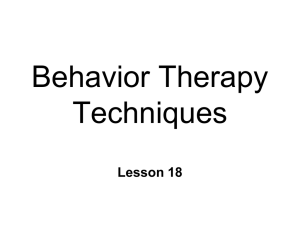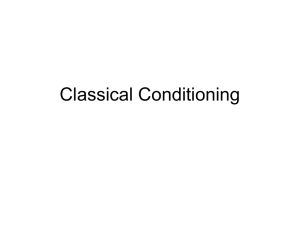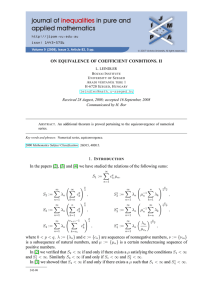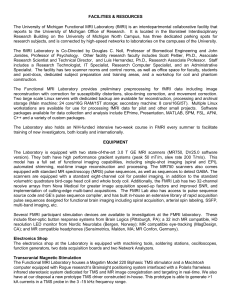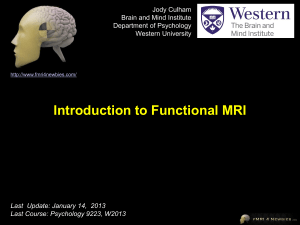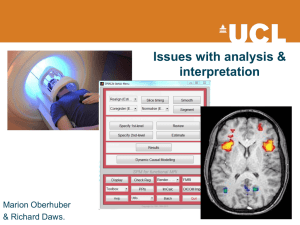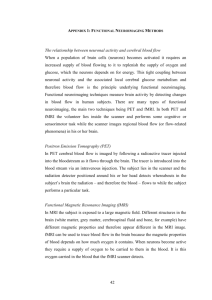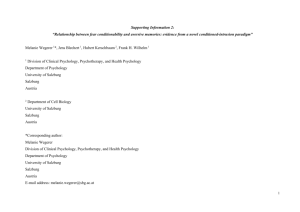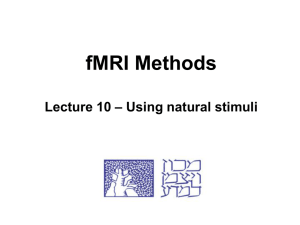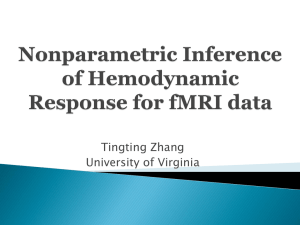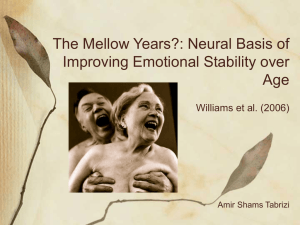Supplementary Methods (doc 286K)
advertisement
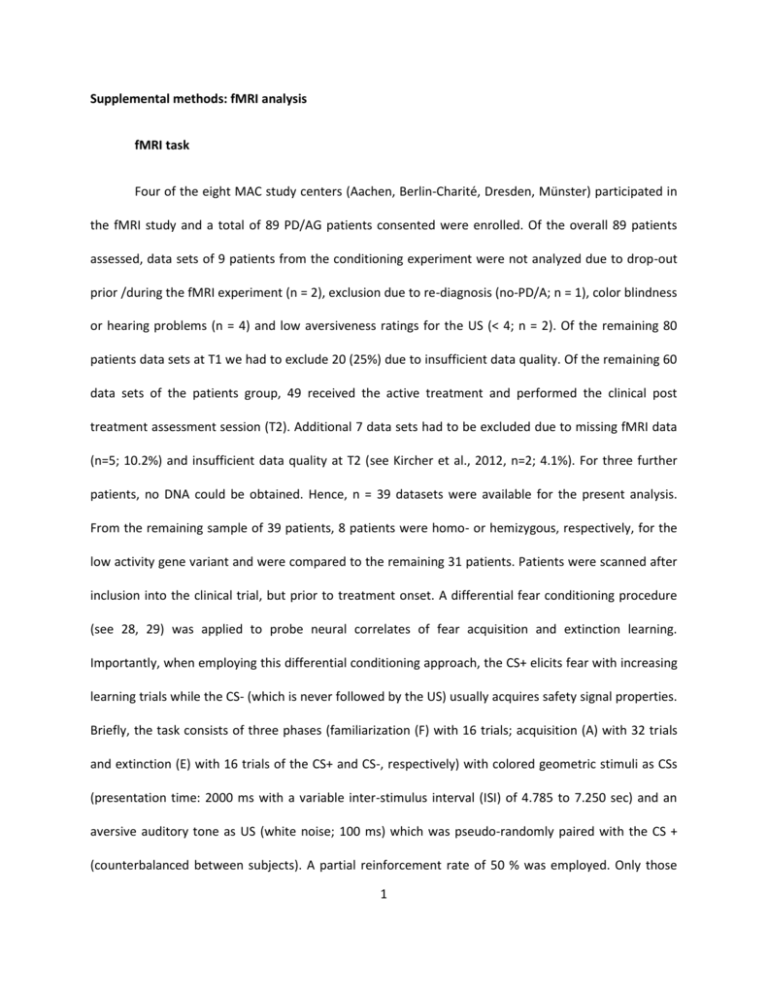
Supplemental methods: fMRI analysis fMRI task Four of the eight MAC study centers (Aachen, Berlin-Charité, Dresden, Münster) participated in the fMRI study and a total of 89 PD/AG patients consented were enrolled. Of the overall 89 patients assessed, data sets of 9 patients from the conditioning experiment were not analyzed due to drop-out prior /during the fMRI experiment (n = 2), exclusion due to re-diagnosis (no-PD/A; n = 1), color blindness or hearing problems (n = 4) and low aversiveness ratings for the US (< 4; n = 2). Of the remaining 80 patients data sets at T1 we had to exclude 20 (25%) due to insufficient data quality. Of the remaining 60 data sets of the patients group, 49 received the active treatment and performed the clinical post treatment assessment session (T2). Additional 7 data sets had to be excluded due to missing fMRI data (n=5; 10.2%) and insufficient data quality at T2 (see Kircher et al., 2012, n=2; 4.1%). For three further patients, no DNA could be obtained. Hence, n = 39 datasets were available for the present analysis. From the remaining sample of 39 patients, 8 patients were homo- or hemizygous, respectively, for the low activity gene variant and were compared to the remaining 31 patients. Patients were scanned after inclusion into the clinical trial, but prior to treatment onset. A differential fear conditioning procedure (see 28, 29) was applied to probe neural correlates of fear acquisition and extinction learning. Importantly, when employing this differential conditioning approach, the CS+ elicits fear with increasing learning trials while the CS- (which is never followed by the US) usually acquires safety signal properties. Briefly, the task consists of three phases (familiarization (F) with 16 trials; acquisition (A) with 32 trials and extinction (E) with 16 trials of the CS+ and CS-, respectively) with colored geometric stimuli as CSs (presentation time: 2000 ms with a variable inter-stimulus interval (ISI) of 4.785 to 7.250 sec) and an aversive auditory tone as US (white noise; 100 ms) which was pseudo-randomly paired with the CS + (counterbalanced between subjects). A partial reinforcement rate of 50 % was employed. Only those 1 trials were analyzed during acquisition in which no US was delivered (16 per condition) to avoid overlap with activation directly related to the presentation of the US (CS+ unpaired). fMRI data acquisition and analysis fMRI brain images were acquired using 3T Philips Achieva (Aachen and Münster), 3T Siemens Trio (Dresden) and 3T General Electric Healthcare (Berlin) scanners. Five-hundred and five transaxial functional images (EPI, 64x64, 30 slices interleaved, FOV= 230, voxel size = 3.6 x 3.6 x 3.8 mm, TE = 30 ms, TR = 2 sec; total duration: 16:49 minutes), covering the whole brain and positioned parallel to the intercomissural line (AC-PC) were recorded. MR images were analyzed using Statistical Parametric Mapping (SPM5; www.fil.ion.ucl.ac.uk) implemented in MATLAB 6.5 (Mathworks Inc., Sherborn, MA). The first five volumes were discarded to minimize saturation effects. A high-pass filter (128-sec cutoff period) was applied to remove low frequency fluctuations in the BOLD signal. To correct for different acquisition times, we shifted the signal measured in each slice relative to the acquisition time of the middle slice using a slice interpolation in time. Functional images were temporally and spatially aligned and normalized into a standard stereotactic space (2 x 2 x 2 mm). To account for differences in intrinsic smoothness between scanners an iterative smoothness equalization procedure was performed. At the single-subject level, realignment parameters were included as regressors into the model to account for movement artifacts. The BOLD response for each event type (CS+ paired, CS+ unpaired, CS-, US) was modeled by the canonical hemodynamic response function within the framework of the general linear model to analyze brain activation differences related to the onset of the different stimuli. Familiarization (F), acquisition (A) and extinction phase (E) was modeled separately, resulting in 9 regressors (F: CS-, CS+, , US; A: CS-, CS+ without US (CS+unpaired), CS presented with the US (CS+paired), 2 E: CS+, CS-, behavioral assessment). Parameter estimates (ß-) and t-statistic images were calculated for each subject. A group analysis was performed by entering contrast images into a flexible factorial analysis, in which subjects are treated as random variables. Low and high active groups were compared with regard to fear conditioning (CS+>CS-) during acquisition and fear extinction (extinction phase). We tested (1) for group differences at t1 and (2) changes after CBT for both experimental phases separately. Therefore, we computed the interaction of the factors genotype group (L vs. H) and contrast CS+/CS- at T1 (H (CS+unpaired > CS-) > L (CS+unpaired > CS-) and vice versa) and the interaction of the factors group, CS and time (T1 (H (CS+unpaired > CS-) > L (CS+unpaired > CS-) > T2 (H (CS+unpaired > CS-) > L (CS+unpaired > CS-) and vice versa). The model included gender, age and an fMRI center as covariate of no interest. Estimated beta values from activation clusters were extracted for bar graph illustrations (see Fig. 2). A Monte Carlo (MC) simulation of the brain volume of the current study was conducted to establish an appropriate voxel contiguity threshold (https://www2.bc.edu/~slotnics/scripts.htm). Assuming an individual voxel type I error of P < 0.005, a cluster extent of 142 contiguous resampled voxels was indicated as sufficient to correct for multiple voxel comparisons at P < 0.05. Thus, for all analyses voxels with a significance level of P < 0.005 uncorrected belonging to clusters with at least 142 voxels are reported. 3 Supplementary Acknowledgements and staff members by site Greifswald (coordinating site for Psychophysiology): Christiane Melzig, Jan Richter, Susan Richter, Matthias von Rad; Berlin-Charite (coordinating Center for Experimental Pharmacology): Harald Bruhn, Anja Siegmund, Meline Stoy, Andre Wittmann; Berlin-Adlershof: Irene Schulz; Münster (Overall MAC Program Coordination, Genetics and Functional Neuroimaging): Andreas Behnken, Katharina Domschke, Adrianna Ewert, Carsten Konrad, Bettina Pfleiderer, Peter Zwanzger; Münster (coordinating site for psychophysiology and subtyping): Judith Eidecker, Swantje Koller, Fred Rist, Anna Vossbeck-Elsebusch; Marburg/Aachen (coordinating center for functional neuroimaging): Barbara Drüke, Sonja Eskens, Thomas Forkmann, Siegfried Gauggel, Susan Gruber, Andreas Jansen, Thilo Kellermann, Isabelle Reinhardt, Nina Vercamer-Fabri; Dresden (coordinating site for data collection, analysis, and the RCT): Franziska Einsle, Christine Fröhlich, Andrew T. Gloster, Christina Hauke, Simone Heinze, Michael Höfler, Ulrike Lueken, Peter Neudeck, Stephanie Preiß, Dorte Westphal; Würzburg Psychiatry Department (coordinating center for genetics): Andreas Reif; Würzburg Psychology Department: Julia Dürner, Hedwig Eisenbarth, Antje B. M. Gerdes, Harald Krebs, Paul Pauli, Silvia Schad, Nina Steinhäuser; Bremen: Veronika Bamann, Sylvia Helbig-Lang, Anne Kordt, Pia Ley, Franz Petermann, Eva-Maria Schröder. Additional support was provided by the coordinating center for clinical studies in Dresden (KKS Dresden): Xina Grählert and Marko Käppler. The RTC project was approved by the Ethics Committee of the Medical Faculty of the Technical University of Dresden (EK 164082006). The neuroimaging components were approved by the Ethics Committee of the Medical Faculty of the RheinischWestfälische Hochschule University Aachen (EK 073/07). The study was registered with the ISRCTN: ISRCTN80046034. 4 Supplementary Table 1 (separate Excel file). Participants in MAC sub-studies, broken down by time point (baseline, intermediate, post therapy) and therapy condition (T+, T-, wait list). As the MAC study included a total of three different fMRI paradigms, and as not every patient underwent each paradigm, the number of patients subjected to the fear conditioning task is smaller than the total number of patients undergoing fMRI. As for the fear conditioning task, only valid datasets are given. BAT, behavioral avoidance task. Supplementary Table 2. Effect of MAOA genotype (dichotomized in high [H] and low [L] activity as defined in Methods) on therapy response in panic disorder when not adjusted for baseline values. For further details see the Methods section and Table 1. HAMA, Hamilton Anxiety scale; CGI, clinical global impression; MI; #PA, number of panic attacks; Mobility inventory; LOCF, last observation carried forward. 5 6 Supplementary Figure S1. Patient flow chart for the fear conditioning fMRI substudy. Aud., auditory; fMRI, functional magnetic resonance imaging; PD/AG, panic disorder with agoraphobia; PSF, percent signal fluctuation index; SFNR, signal-to-fluctuation-noise-ratio; Vis., visual (from Kircher et al., 2012). Additional reference: Kircher, T., Arolt V., Jansen A., Pyka M., Reinhardt I., Kellermann T., Konrad C., Lueken U., Gloster A.T., Gerlach A.L., Ströhle A., Wittmann A., Pfleiderer B., Wittchen H.U., Straube B.. (2012) Effect of CognitiveBehavioral Therapy on Neural Correlates of Fear Conditioning in Panic Disorder. Biol Psychiatry, 2012 Aug 23. [Epub ahead of print] 7
